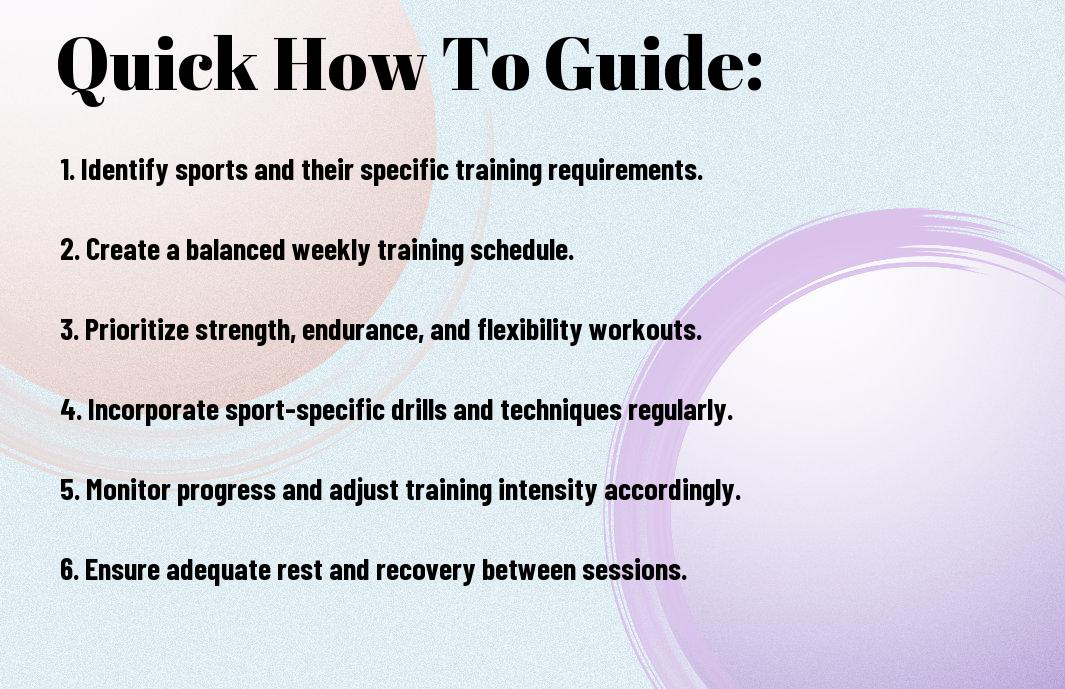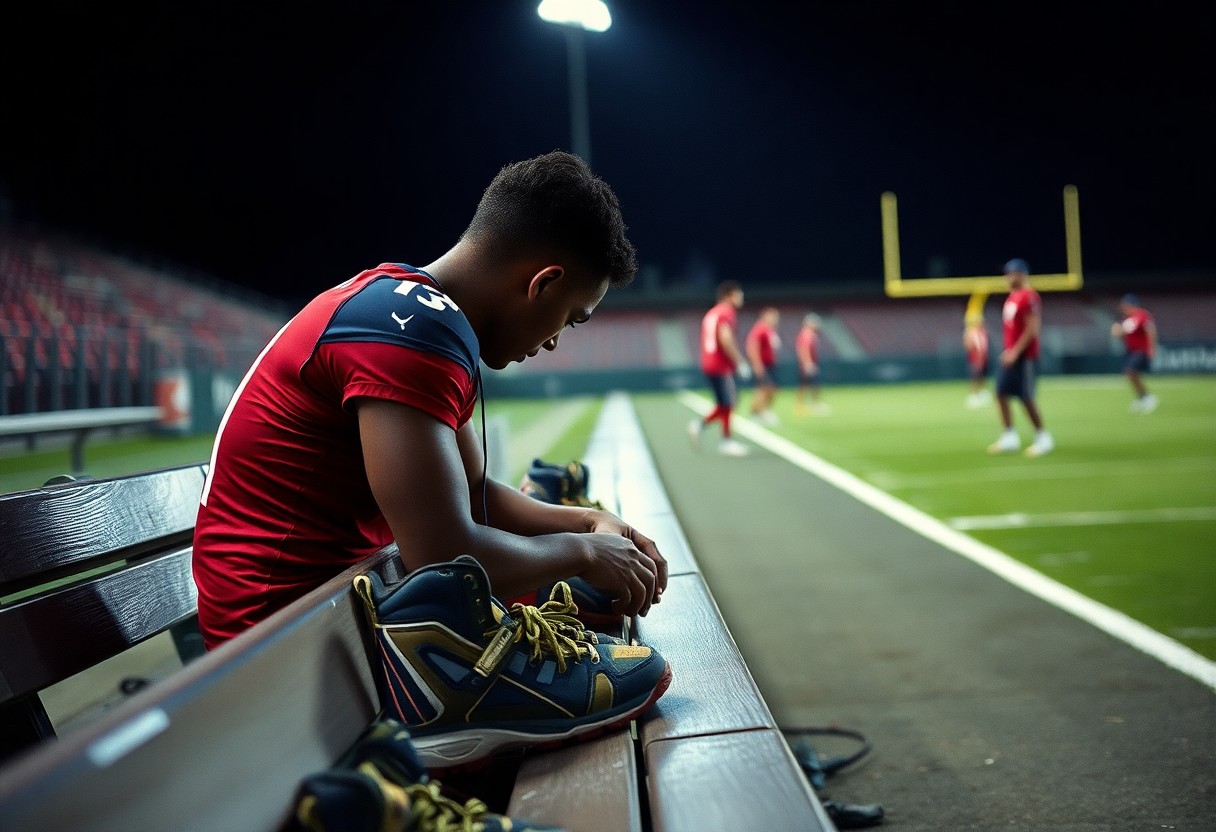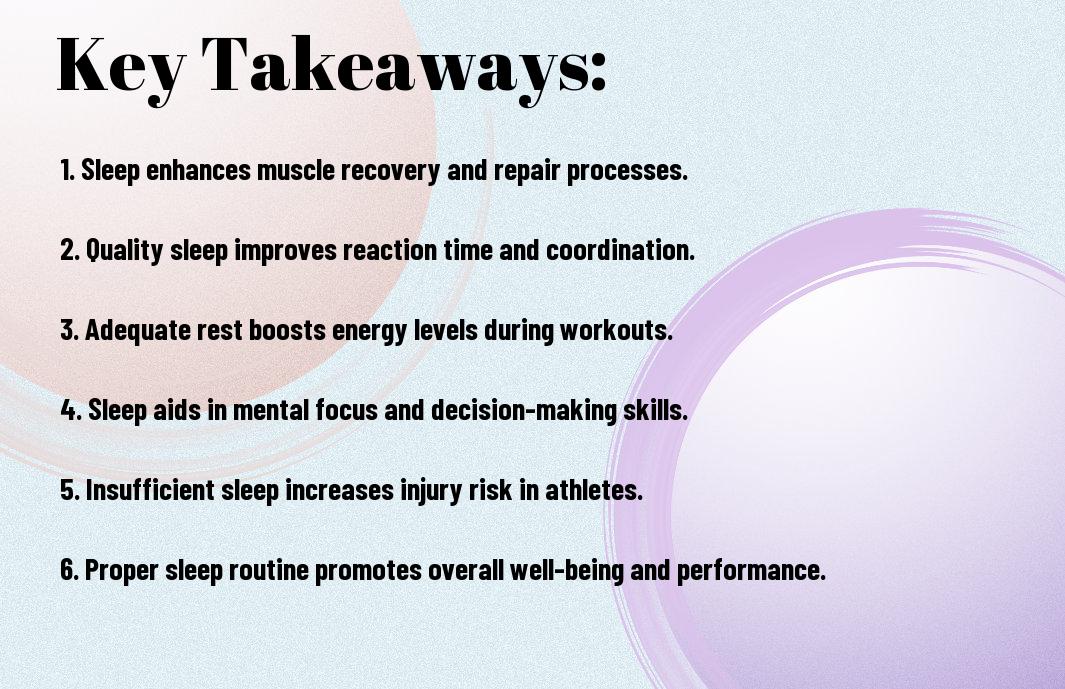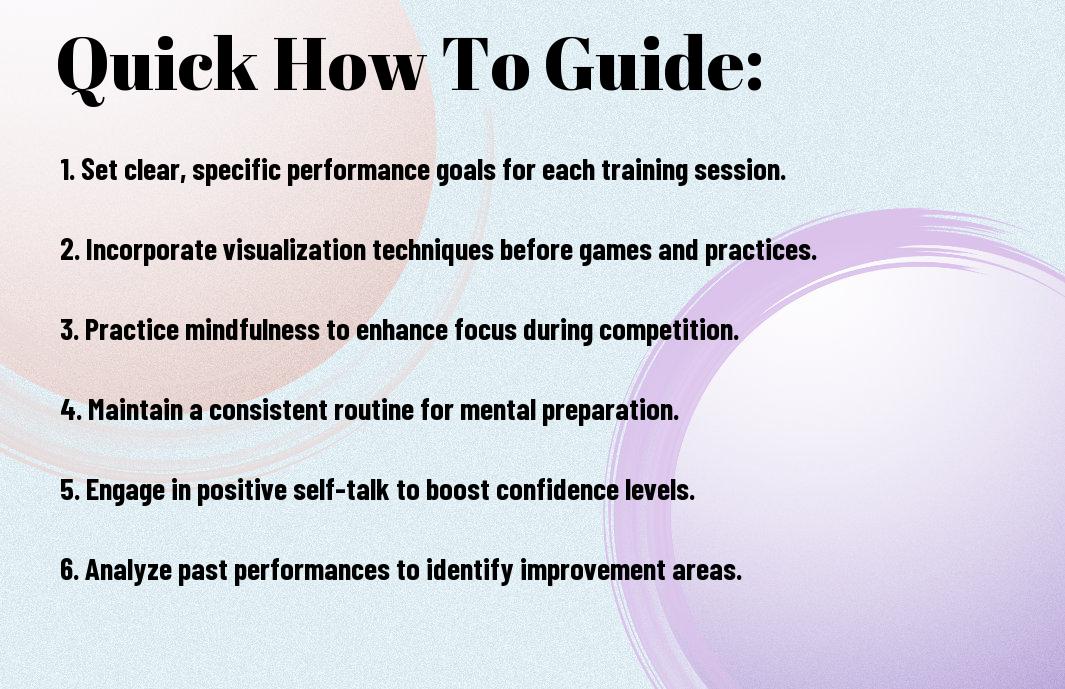Performance optimization across various sports requires a strategic approach to training. By understanding the specific demands of each sport and integrating them into your routine, you can effectively develop your skills and enhance overall fitness. This guide will provide you with actionable tips and methods to create a balanced training program that accommodates your unique athletic pursuits while minimizing the risk of injury and burnout.
Key Takeaways:
- Balanced Training Schedule: Create a training plan that allocates specific days for each sport to ensure equal focus and energy distribution.
- Cross-Training Benefits: Incorporate exercises from different sports to enhance overall fitness, reduce monotony, and prevent injuries.
- Nutrition and Recovery: Prioritize a balanced diet and proper recovery strategies to support intense training for multiple sports.
- Skill Development: Dedicate time to practice the fundamental skills of each sport, ensuring that proficiency is maintained across disciplines.
- Monitoring Progress: Keep track of performance metrics in each sport to identify areas for improvement and adjust the training plan as needed.

Understanding the Basics of Multi-Sport Training
As you begin on the journey of training for multiple sports, it’s crucial to grasp the fundamentals of multi-sport training. This approach requires a strategic combination of workouts, recovery, and nutrition tailored to meet the demands of each sport. By effectively balancing your training regimen, you can enhance your performance across different athletic disciplines while minimizing the risk of injury.
Key Factors to Consider
To successfully train for various sports, you should consider the following key factors:
- Evaluate your current fitness level.
- Understand the demands of each sport.
- Incorporate cross-training and recovery strategies.
- Stay attentive to nutrition and hydration.
Assume that finding the right balance among these factors will help optimize your performance.
The Importance of Proper Planning
Consider the significance of having a well-structured training plan when undertaking multi-sport training. A clear schedule helps you allocate time effectively between different sports while allowing adequate recovery periods. This organized approach helps you track your progress and adapt your regimen as needed.
For instance, if you’re training for both swimming and running, you might delineate your week by assigning specific days for each sport, ensuring you have rest days in between to facilitate recovery. This method allows you to monitor your strengths and weaknesses in both disciplines, enabling you to adjust your training focus and maximize your performance when competition time arrives. By establishing a roadmap for your training, you’ll feel more equipped to tackle the challenges of competing in multiple sports.

Setting Up Your Training Schedule
You need a well-structured training schedule that accommodates your multiple sports commitments, ensuring you develop skills and endurance in each. Start by evaluating the time you can dedicate to training each week, then break down your sessions by sport, prioritizing workouts that require more focus based on competition dates or personal goals. This organization allows you to maintain a balanced approach, fueling your passion for each sport while preventing burnout.
Balancing Workout Frequency
Workout frequency is key to optimizing your performance across different sports. You should aim for a balanced distribution of training sessions, ensuring you dedicate appropriate time to each sport without overloading yourself. Assess your energy levels and the demands of each sport to create a regimen that enhances skills effectively while providing ample recovery time.
Incorporating Rest and Recovery
Schedule dedicated rest days and active recovery sessions into your training plan. You need to listen to your body and recognize when it requires a break to avoid fatigue and potential injury. Incorporate low-intensity activities like stretching, yoga, or light jogging on recovery days, allowing your muscles to recuperate effectively while keeping your routine active.
The inclusion of rest and recovery in your training schedule will significantly impact your athletic performance. Prioritizing sleep, nutrition, and hydration plays a vital role in your recovery process. Use techniques like foam rolling or contrast baths to support muscular recovery and improve mobility. Always adjust your training based on how your body feels; this mindfulness will keep you in peak condition across all the sports you engage in.
Nutrition Tips for Multi-Sport Athletes
Your nutrition is necessary for optimizing performance across multiple sports. Focus on a balanced diet that supports your training regimen, recovery time, and energy needs.
- Prioritize whole foods: fruits, vegetables, lean proteins, whole grains.
- Incorporate healthy fats: avocados, nuts, and olive oil.
- Plan meals around your training schedule for optimal energy.
- Consider meal prepping to ensure you have nutritious options readily available.
- Consult a sports nutritionist for personalized advice based on your specific needs.
Any adjustments to your nutrition can enhance your performance across the board.
Fueling Your Body for Performance
The right fuel can make all the difference in your athletic performance. Focus on complex carbohydrates for sustained energy, adequate protein for muscle repair, and healthy fats to support overall health. Tailor your macronutrient distribution according to the demands of each sport, ensuring that your body receives the nutrients it needs to excel.
Hydration Strategies
Some athletes often overlook hydration as a key element of performance. Staying hydrated is necessary not only for endurance and stamina but also for recovery and cognitive function. Your hydration needs can vary based on the sport, duration of activity, and environmental conditions.
Understanding the importance of hydration involves recognizing that even mild dehydration can impair performance. Aim to drink water regularly throughout the day, and consider replenishing electrolytes after intense workouts. Pay attention to your body’s signals, and adjust your fluid intake accordingly, especially during extended training sessions or competitions in hot weather. Staying well-hydrated will keep you sharp and ready for every challenge you face in your multi-sport endeavors.
Developing Sport-Specific Skills
Despite the challenges of juggling multiple sports, developing sport-specific skills is crucial. You must hone your abilities in distinct areas for each sport while ensuring your overall training remains balanced. Prioritizing skill development will enhance your performance and make you a more versatile athlete. With commitment and focused practices, you can achieve proficiency in various disciplines that complement one another.
Identifying Core Skills for Each Sport
There’s a wide range of skills needed across different sports, and identifying the core skills for each sport is the first step in effective training. Start by considering the key movements, techniques, and strategies unique to the sports you practice. This understanding will guide your practice and help you maintain a high skill level in all areas.
Tips for Skill Transfer Between Sports
Developing skills that transfer between sports can accelerate your training process and improve your overall athletic performance. Focus on practice techniques and movements that are common in both sports. Utilize the following tips to maximize skill transfer:
- Identify overlapping techniques and movements.
- Incorporate drills that develop related skills.
- Focus on physical attributes like endurance and agility.
After implementing these strategies, you will notice enhanced responsiveness and adaptability across your sporting disciplines.
Transfer between sports is an effective strategy for improving your overall skill set. By actively drawing connections between the skills of your chosen sports, you can become a more well-rounded athlete. Utilize the following methods to facilitate this process:
- Analyze how specific skills correlate between sports.
- Practice integration drills that emphasize both sports.
- Stay mindful of how each sport helps develop your athleticism.
After exploring these methods, you will find that your confidence and performance in each sport will mutually benefit from the skills acquired in others.
Monitoring Progress and Making Adjustments
Unlike training for a single sport, juggling multiple athletic pursuits requires a keen awareness of your progress. Regular monitoring of your performance helps ensure that you stay on track toward achieving your goals. By assessing your training data and physical feedback, you can identify areas of improvement and make necessary adjustments to your regimen to enhance performance across all sports.
Using Metrics to Track Performance
Using metrics such as heart rate, distance covered, and personal records can provide you with valuable insights into your training effectiveness. Tracking these numbers allows you to pinpoint your strengths and weaknesses, ensuring that you allocate your training time efficiently across various sports to optimize performance without overtraining.
Adapting Training Based on Results
Using ongoing results, you can refine your training plan to better meet the demands of each sport you participate in. Regular reassessment of your goals, performance metrics, and physical condition enables you to adjust your workouts, recovery strategies, and even nutrition to achieve optimal results.
Metrics play a significant role in determining how effectively your training aligns with your performance goals in multiple sports. By analyzing this data, you can identify patterns and trends, which can guide your training focus. If you notice a decline in performance in a specific area, you may need to adjust your training volume or intensity for that sport. Conversely, if you excel in one sport, you might choose to maintain that intensity while shifting focus to another area where improvement is needed. This adaptive approach fosters balanced development and keeps you progressing efficiently across all your athletic endeavors.
Mental Preparation and Focus
To excel as a multi-sport athlete, sharpening your mental preparation and focus is necessary. This involves visualizing your performance and maintaining a positive mindset, which can be supported by incorporating techniques from Multi-Sport Athlete? 5 Ways to Keep Running in the Mix. By establishing clear goals and creating a structured training plan, you can enhance your concentration and resilience during practice and competition.
Strategies for Maintaining Motivation
Clearly, maintaining motivation in a multi-sport training regimen requires variety and goal-setting. Mixing up your training sessions and setting short-term milestones can keep the experience fresh and exciting. Consider seeking support from fellow athletes or joining local clubs to foster a sense of community, which can further ignite your passion and commitment.
Importance of Mental Resilience
Any athlete engaged in multiple sports must develop mental resilience to face challenges effectively. By embracing setbacks as opportunities for growth, you will strengthen your ability to overcome obstacles and maintain focus. Regularly practicing mindfulness and reflection can significantly enhance your resilience, enabling you to adapt to the demands of competing in various sports.
To cultivate mental resilience, consider adopting techniques such as journaling your experiences or mindfulness meditation. Acknowledging and processing your emotions will allow you to maintain a balanced outlook on your training journey. By focusing on both your successes and areas for improvement, you’ll foster a growth mindset that helps you navigate the ups and downs of being a multi-sport athlete.
Final Words
On the whole, effectively training for multiple sports concurrently demands a thoughtful approach to balance intensity, recovery, and skill development. You should prioritize a well-structured schedule that accommodates various training needs while ensuring adequate recuperation. Incorporating cross-training methods can enhance your overall athleticism without overexerting specific muscle groups. Stay vigilant for signs of fatigue and adjust your program as necessary to maintain peak performance. By integrating these strategies, you can foster your athletic growth across different sports while minimizing the risk of burnout or injury.
Q: What are the key principles to follow when training for multiple sports at the same time?
A: When training for multiple sports, it’s important to establish a structured program that accommodates the unique demands of each sport. Some key principles include:
- Periodization: Create a training schedule that divides your training into distinct periods focusing on different aspects, such as endurance, strength, and skill development for each sport.
- Cross-Training: Incorporate exercises that support the skills and physical requirements of both sports. Activities that enhance your cardiovascular endurance, flexibility, and overall strength are beneficial.
- Recovery: Prioritize rest and recovery to prevent overtraining, ensuring that your body has adequate time to adapt and heal from your workouts.
Q: How do I manage recovery and rest days while training for multiple sports?
A: Managing recovery and rest days is imperative to avoid fatigue and injury when training for multiple sports. Here are some strategies:
- Listen to Your Body: Pay attention to signs of fatigue or soreness and adjust your training intensity or volume accordingly.
- Active Recovery: On designated rest days, consider engaging in low-impact activities such as yoga, swimming, or light jogging to promote blood flow and aid recovery without taxing your body excessively.
- Schedule Rest Days: Allocate specific days solely for rest, ensuring that they align with your overall training plan. This can help you recharge both mentally and physically.
Q: How can I balance training volume and intensity for different sports without compromising performance?
A: Balancing training volume and intensity for different sports can be achieved through careful planning and monitoring. Here’s how:
- Prioritize Key Workouts: Identify which sessions are most important for performance in each sport and prioritize them in your training week. This may mean scheduling higher intensity workouts for one sport earlier in the week, followed by more moderate sessions for the other sport.
- Monitor Your Workload: Keep a log of your workouts, noting the intensity and volume. Use this data to ensure that neither sport becomes too taxing compared to the other, and adjust your workouts as necessary.
- Incorporate Flexibility: Be adaptable with your training schedule. If one sport requires more focus or training intensity, adjust the volume for the other sports to maintain balance and avoid burnout.







